
Metro-North Railroad, trading as MTA Metro-North Railroad, is a suburban commuter rail service operated by the Metropolitan Transportation Authority (MTA), a public authority of the U.S. state of New York. Metro-North serves the New York Metropolitan Area, running service between New York City and its northern suburbs in New York and Connecticut, including Port Jervis, Spring Valley, Poughkeepsie, Yonkers, New Rochelle, Mount Vernon, White Plains, Southeast and Wassaic in New York and Stamford, New Canaan, Danbury, Bridgeport, Waterbury, and New Haven in Connecticut. Service in Connecticut is operated under contract with the Connecticut Department of Transportation. Metro-North also provides local rail service within the New York City boroughs of Manhattan and the Bronx.

Poughkeepsie station is a Metro-North Railroad and Amtrak stop serving the city of Poughkeepsie, New York. The station is the northern terminus of Metro-North's Hudson Line, and an intermediate stop for Amtrak's several Empire Corridor trains.
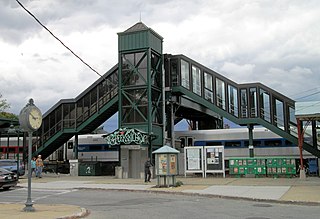
Peekskill station is a commuter rail stop on the Metro-North Railroad's Hudson Line, located in Peekskill, New York.

Croton–Harmon station is a train station in Croton-on-Hudson, New York. It serves the Metro-North Railroad's Hudson Line and all Amtrak lines running along the Empire Corridor. It is the main transfer point between the Hudson Line's local and express service and marks the northern endpoint of third-rail electrification on the route.
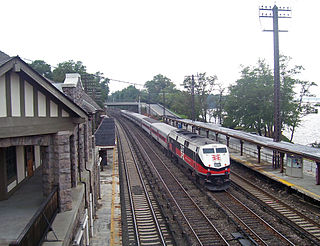
Philipse Manor station is a commuter rail stop on the Metro-North Railroad's Hudson Line, located in the Philipse Manor area of Sleepy Hollow, New York, United States.

Hastings-on-Hudson station is a commuter rail stop on the Metro-North Railroad's Hudson Line, located in Hastings-on-Hudson, New York.
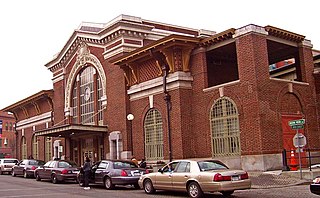
Yonkers station is a Metro-North Railroad and Amtrak railroad station located near Getty Square in Yonkers, New York. It is served by Metro-North Hudson Line commuter rail service and five Amtrak intercity services. The station building was constructed in 1911–1912, replacing an older structure.

Spuyten Duyvil station is a commuter rail stop on the Metro-North Railroad's Hudson Line, serving the Spuyten Duyvil neighborhood of the Bronx, New York City.

Marble Hill station is a commuter rail stop on the Metro-North Railroad's Hudson Line, serving the Marble Hill neighborhood of Manhattan in New York City. The station is located at 125 West 225th Street, two blocks west of the Broadway Bridge on the north side of the Harlem River, near the New York City Subway's Marble Hill–225th Street station.

Chappaqua station is a commuter rail stop on the Metro-North Railroad's Harlem Line, located in Chappaqua, New York, United States, within the town of New Castle.

Scarsdale station is a commuter rail stop on the Metro-North Railroad's Harlem Line, located in Scarsdale, New York. Scarsdale is the southernmost station on the two-track section of the Harlem Line; a third track begins to the south.

The Hudson Line is a commuter rail line owned and operated by the Metro-North Railroad in the U.S. state of New York. It runs north from New York City along the east shore of the Hudson River, terminating at Poughkeepsie. The line was originally the Hudson River Railroad, and eventually became the Hudson Division of the New York Central Railroad. It runs along what was the far southern leg of the Central's famed "Water Level Route" to Chicago.
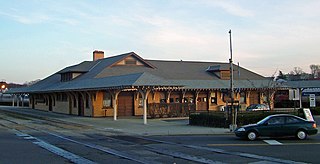
The Danbury Railway Museum is a railway museum housed in the former Union Station on the east end of downtown Danbury, Connecticut, United States. It was established in the mid-1990s following the closure of the station by the Metro-North Railroad in favor of a new station nearby, and primarily focuses on the history of railroading in southern New England and neighboring New York. In addition to the former station building, the museum has a collection of heritage railcars in the neighboring rail yard it shares with Metro-North.

Croton Falls station is a commuter rail stop on the Metro-North Railroad's Harlem Line, located in North Salem, New York.

Katonah station is a commuter rail stop on the Metro-North Railroad's Harlem Line, located in Katonah, New York.

New Rochelle station is a Metro-North Railroad and Amtrak train station located in New Rochelle, New York. The station serves Metro-North's New Haven Line and Amtrak's Northeast Regional; Bee-Line Bus System buses serve a bus stop just outside the station. As of August 2006, weekday commuter ridership was 4,020, and there are 1,381 parking spots. It is the busiest New Haven Line station in Westchester County.

Upper Montclair is a New Jersey Transit station in Upper Montclair, New Jersey, a census-designated place of Montclair, New Jersey. The station is part of the Montclair-Boonton Line. The station is located between two grade level crossings on Bellevue Avenue and Lorraine Avenue, and between North Mountain Avenue and Upper Montclair Plaza parallel to the railroad, and is within steps of the Upper Montclair Business District. The station is 13.7 miles (22.0 km) on the Boonton Line. Closing the grade crossing of Lorraine Avenue is being considered for safety reasons.
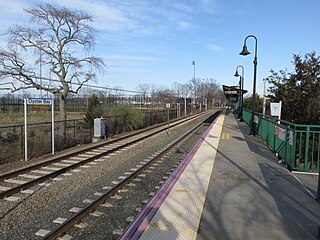
Oyster Bay is the terminus on the Oyster Bay Branch of the Long Island Rail Road. The station is located off Shore Avenue between Maxwell and Larabee Avenues. It is a sheltered concrete elevated platform that stands in the shadows of the original station, which was accessible from the ends of Maxwell, Audrey, and Hamilton Avenues. Both stations exist along the south side of Roosevelt Park.
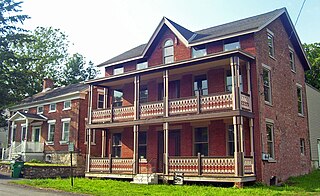
The Main Street Historic District in New Hamburg, New York, United States is located along that street just west of the train station. Six buildings on a single acre are an intact remnant of the hamlet as it was developed in the middle of the 19th century, prior to the Hudson River Railroad's construction, which cut it in half.

North Easton station is a former railroad station designed by noted American architect H. H. Richardson. It is located just off Oliver Street in North Easton, Massachusetts, and currently houses the Easton Historical Society. The station was built in 1881 and served commuter trains until 1958. It was added to the National Register of Historic Places in 1972 as Old Colony Railroad Station. In 1987, it also became part of the H. H. Richardson Historic District of North Easton, a National Historic Landmark District. The proposed Phase 2 of South Coast Rail would return commuter rail service to the location in 2030 as Easton Village station.























